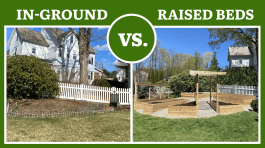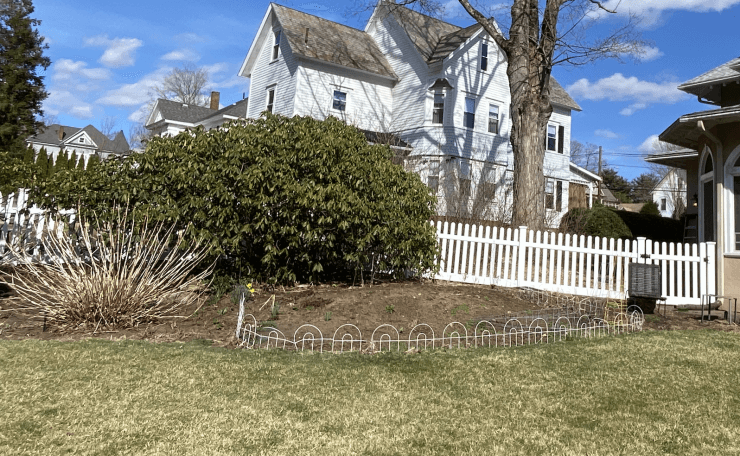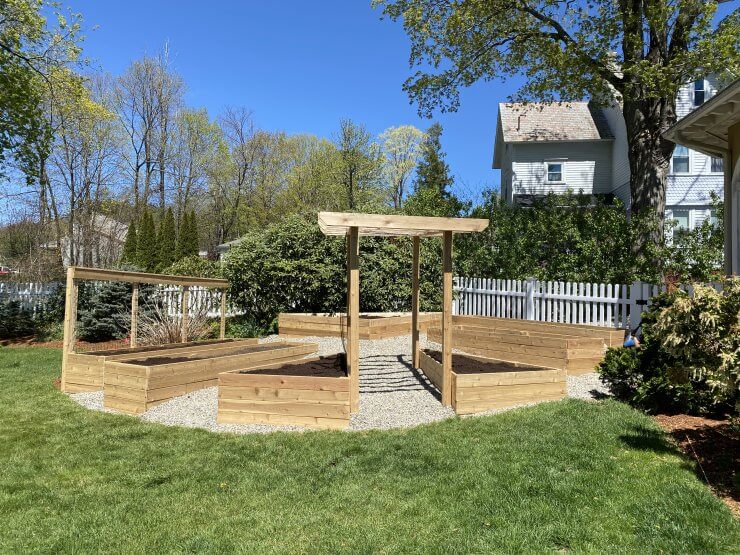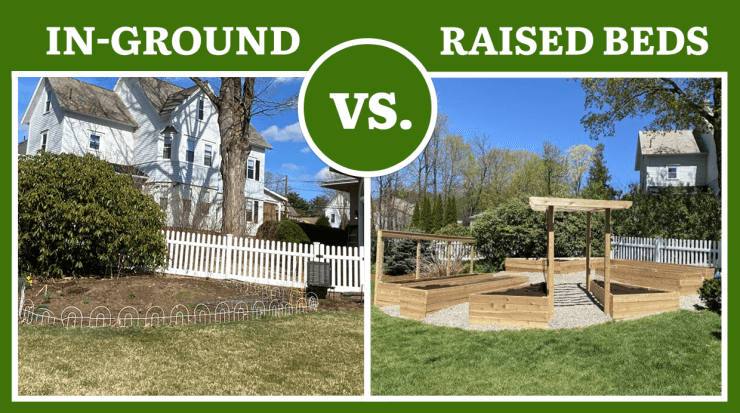
If you’re thinking of making the switch and going from an in-ground garden to planting in raised beds, this list will help you decide.
Forget everything you know about gardening. Hold up. Maybe that’s a bad idea. But if you’ve always had an in-ground garden and you’re planting in raised beds this year, there are some differences you may want to know about. I recently turned my very low-maintenance in-ground garden into a fully raised-bed garden. Mostly for the vanity of it (let’s be honest, they’re just prettier) but also I’m getting old and my back hurts…get off my lawn.
If you’re thinking of doing the same, let’s weigh the differences and take a look at the transformation from my in-ground garden to raised beds.
Before:
Since we moved into our house a few years ago, I knew I wanted raised beds, but as luck would have it, I waited until we had a lumber crisis to make that decision. Before, I tilled a large but simple plot in my yard, with a surprisingly effective little white fence to keep the dog out. Every fall I cleaned it up, every spring I tilled it. I lucked out, because the previous owners were extra fancy gardeners. I’ve been told by their old landscaper that they used really expensive organic soil in their garden, so I’ve truly been able to grow anything I want in this soil and I wasn’t looking forward to giving that up. However, it would get a bit unruly come the end of summer, and a little sad to look at, if we’re being honest.

Garden before. This plot has grown me much food over the years!
After:

Garden after. There will be beans and peas growing up the left trellis, and squash and melons growing up the arbor.
And here’s what we built this spring with the help of a local woodworker. We added about 6 more feet to the garden, maybe a little more, and created almost a half-circle. With these beds, I’ve been able to plant so much more, and weeding has been incredibly easy in comparison, though some of the beds are a little harder to lean over than others.
What was learned from all this? Well, that planting in raised beds is a privilege, not a necessity, but it comes with more extra work than I expected.
But don’t worry. It’s not that different to plant in raised beds. Yes, you’ll need to adjust a few things, and it’s more maintenance, but it’s not like you’re switching cell phone companies. You may need to water a little more or less, or time your planting a little differently, but overall, the differences between planting in raised beds vs. in-ground gardens aren’t going to throw you for a loop. Here are some of the biggest things you may come across.
The unofficial list of big differences between planting in raised beds vs. planting right in the ground
Stop! This is an unofficial list, but I have to give you an official warning: It is not a pros and cons list. I’m not here to say one is better than the other. They’re just different. It’s up to you to decide whether planting in raised beds seems like a better or worse choice than planting your garden in the ground directly. So with that in mind, here we go.
Soil quality. Soil quality is one reason many people decide that planting in raised beds is right for them. You don’t have to worry as much about lead or other toxic debris or runoff. If you have a lot of clay in your soil, that’s not a problem either, in fact, it can help your raised beds stay moist to have that as the ground underneath. Of course, the flip side is that it can get pretty expensive to buy garden soil if you have a large raised bed garden. In my case, I needed to have it delivered, though that’s mostly a one-time cost because you can always use compost and bagged soil in the years following.
Cost. Speaking of expenses, it’s not just the garden soil that can make planting in raised beds more expensive. The frames can add up, too. That’s not to say it has to cost a lot; you can use straw bales or pine as relatively inexpensive framing options. It is something to consider, though. I built my raised beds with cedar during a time where there’s a lumber shortage and prices are up 130%. That one hurt.
Landscape. Unless your ground is perfectly flat, you may be building raised beds on a slope, which can add to the cost if you’re not building yourself, or the sweat equity if you are. Planting in-ground means you don’t have to worry about landscape, and you can always level the soil as needed.
Maintenance. This could probably be an article on its own, and you could argue what does or does not constitute maintenance. Briefly, though, if you’re planting in a raised bed, you will need to do some occasional repair or upkeep. Sides deteriorate, joints come undone, or your neighbor accidentally backs a car into it. This probably won’t be anything you need to deal with right away or even every season, but eventually, you’ll need to do some repairs. Using untreated cedar for your beds will help them last longer, about 10-15 years or longer.
Planting. Once we move away from the set-up and equipment, this is where some of the most significant differences come in. The soil in raised beds generally warms up earlier in the spring, so you can start planting outdoors earlier. This is ideal for some of those veggies that don’t like to get transplanted. However, vining vegetables, such as watermelons or cantaloupes, which want a longer growing season, can grow as far and wide as they want when you plant them directly in the ground.
Watering. There’s no way around it; planting in raised beds also means you should plan to water more often. All that exposed siding that helps the soil warm up more quickly also means that water can evaporate more quickly. Installing a sprinkler on a timer, or other irrigation is a good idea, here is how I created a drip irrigation system for my raised beds.
Mulching. All of us at Food Gardening Network are big fans of mulching for a variety of reasons. It can help the soil retain moisture, decrease the number of weeds that grow, help equalize soil temperature, and improve soil health. But as far as mulching being different in a raised bed than it is for an in-ground garden? I honestly don’t know that it matters. You might have a lot more soil to cover without raised beds, but otherwise, I haven’t noticed any differences myself, and I can’t find anything in my sources about it being different. So, mulch away!
Weeding and plant care. This is by far one of my favorite parts of planting in raised beds, especially taller raised beds. Weeding and plant care are so much easier, less bending, more pulling.
As you can see, the biggest differences aren’t really all that big. Hear me out, though. The cool thing about gardening is that there is usually more than one right way to do something. That means you could go wild and mix things up. Plant a raised bed garden and an in-ground garden.
How about you? Have you found there are any big differences between planting in raised beds vs. in-ground gardens?


 Previous
Previous



Of course, you also can have raised beds, with paths for walking without all the lumber and framing!
Thanks so much for this article, Amanda. I’m working toward my first raised bed after many years of in-ground gardening. I’m looking forward to having a easier time weeding, and bringing in better quality soil for it. I’ve been reading a lot on different bed materials for the frame. I appreciate your suggestion. I thought plastic decking might be the answer, but Kansas State folks have had problems with it warping.